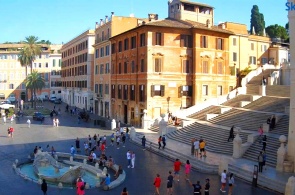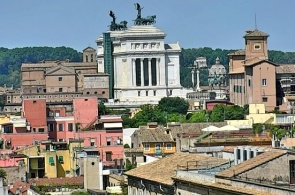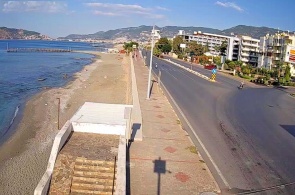Rome is not only an abundance of ancient architectural monuments, museums and fine art galleries. There are also a huge number of picturesque parks, many of which are several centuries old.
One of the most beautiful locations in the city is the Appian Way. It bears the name of the Roman consul, who was the founder of the main city artery, founded in 312 BC. Almost 500 years later, it was extended to Brindisi itself.
Today this place is considered to be truly exclusive. It is a cobbled thoroughfare surrounded by green fields, old buildings and tall relict trees. The most beautiful structure next to the road is Villa dei Quintili. The Emperor Commond was so fascinated by the beauty of this building that he killed its previous owner in order to take possession of the villa.
But the Appian Way is associated with even darker pages in the history of the Roman Empire. It was here in the 1st century AD that Spartacus and 6,000 of his slaves were crucified. It was also in this place that the first Christians were buried from deep catacombs. Today, visiting the dungeons is public. Their total length reaches 300 km, but only three catacombs are open for tourists.
The four patriarchal basilicas of Rome include Santa Maria Maggiore. It was built in the 5th century and crowns the Esquiline Hill in the place where snow fell in the summer of 358. Today, in memory of this event, every year on August 5, thousands of snow-white petals are lowered from the coffered ceiling of the temple.
The architectural appearance of the basilica has changed many times. Today the building has a 14th century Romanesque bell tower, snow-white 18th century baroque facades and exquisite ancient mosaics dating from the 5th century.
Among the greatest museums not only in the city, but also in the world is the Roman National Museum. It contains brilliant works of art. Samples of classical sculpture are located on the first and second floors. Another part of the second floor is reserved for a collection of amazing frescoes.
The stunning gallery, which is located behind the ancient facades of Palazzo Doria Pamphilj, can continue the walk. Within the walls of the palace, among the luxurious interiors, there are works by Raphael, Titian, Caravaggio, Tintoretto, Bernini, Velazquez and Flemish artists. The gem of the collection is the portrait of Pope Innocent X.
One of the most beautiful locations in the city is the Appian Way. It bears the name of the Roman consul, who was the founder of the main city artery, founded in 312 BC. Almost 500 years later, it was extended to Brindisi itself.
Today this place is considered to be truly exclusive. It is a cobbled thoroughfare surrounded by green fields, old buildings and tall relict trees. The most beautiful structure next to the road is Villa dei Quintili. The Emperor Commond was so fascinated by the beauty of this building that he killed its previous owner in order to take possession of the villa.
But the Appian Way is associated with even darker pages in the history of the Roman Empire. It was here in the 1st century AD that Spartacus and 6,000 of his slaves were crucified. It was also in this place that the first Christians were buried from deep catacombs. Today, visiting the dungeons is public. Their total length reaches 300 km, but only three catacombs are open for tourists.
The four patriarchal basilicas of Rome include Santa Maria Maggiore. It was built in the 5th century and crowns the Esquiline Hill in the place where snow fell in the summer of 358. Today, in memory of this event, every year on August 5, thousands of snow-white petals are lowered from the coffered ceiling of the temple.
The architectural appearance of the basilica has changed many times. Today the building has a 14th century Romanesque bell tower, snow-white 18th century baroque facades and exquisite ancient mosaics dating from the 5th century.
Among the greatest museums not only in the city, but also in the world is the Roman National Museum. It contains brilliant works of art. Samples of classical sculpture are located on the first and second floors. Another part of the second floor is reserved for a collection of amazing frescoes.
The stunning gallery, which is located behind the ancient facades of Palazzo Doria Pamphilj, can continue the walk. Within the walls of the palace, among the luxurious interiors, there are works by Raphael, Titian, Caravaggio, Tintoretto, Bernini, Velazquez and Flemish artists. The gem of the collection is the portrait of Pope Innocent X.
More details
The Rome webcam shows the Colosseum amphitheater and the Temple of Venus and Roma. The camera lens captures a grand ancient Roman structure, next to which are the ruins of an ancient temple. This is one of the most visited places in the world. The broadcast is conducted in real time.
Rome, Italy
27.03.25
Rome webcam with a view of the beach of the Nettuno resort. The lens covers a wide sandy beach, adjacent infrastructure facilities. The real-time broadcast allows you to take a pleasant virtual walk to the warm coast of the Tyrrhenian Sea.
Rome, Italy
09.06.23
Camera overlooking the UNESCO World Heritage Site - Trevi Fountain in Rome. The lens covers almost the entire composition of a hydraulic structure, houses and people adjacent to it. The broadcast is carried out in real time, so anyone can see this work of art, wherever he is.
Rome, Italy
24.09.21
The webcam is broadcasting from the Plaza de España in Rome. The lens covers the famous Spanish Steps, as well as the spacious landing at its base. The center of the square is decorated with the famous Barcaccia fountain, made in the Baroque style by the ingenious project of Pietro Bernini. The broadcast is conducted online.
Rome, Italy
23.09.21
A unique monument of history, culture and architecture - the Roman Pantheon - gets into the lens of the webcam. The overview covers the ancient fountain that adorns the square in front of the Pantheon, the landmark itself, as well as the houses adjacent to the square. The broadcast is carried out in real time.
Rome, Italy
23.09.21
popular camerasshow all
Sultanahmet or Blue mosque is a work of art of Turkish-Islamic architecture. Its construction began in 1609, the construction work took seven years to a 19-year-old Sultan. The name of the mosque was, due to its interesting and unique finish.
Istanbul, Turkey
Stavanger, a town in the commune of Norway, located in the South-Western part of the country, on the Peninsula, rich in minerals. Tanager combines the influence of foreign organisations such as NATO and oil companies. The camera will shoot the harbour and the promenade of the city.
Stavanger, Norway
A webcam broadcasts the district of Tosmur - quiet location in the Eastern part of Alanya, located only five kilometres from the city centre. Its rural way of life and the beauty of untouched nature attract tourists.
Alanya, Turkey
Shark Island or in English of Shark island, located in the harbour city of Sydney, the suburb of Point Piper. The locals, the natives named the island Boambilly, which translated means Shark island. After all, this name is not casual, because it's mean and looks like a shark fin.
Sydney, Australia
The webcam is installed on site Alva. Tsaghkadzor ski resort town in Armenia. Tsaghkadzor is a beautiful mountainous area among deciduous forests, with a pleasant winter climate, and clean fresh air. The highest point is 1800 meters. The truss type is a classic, divided into three.
Tsakhkadzor, Armenia














